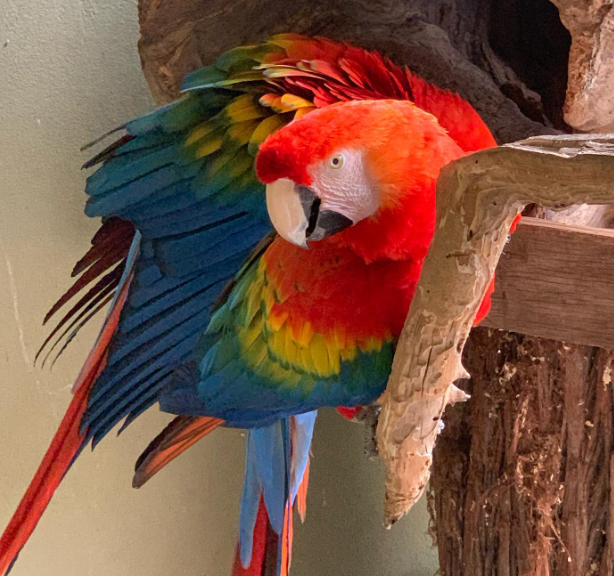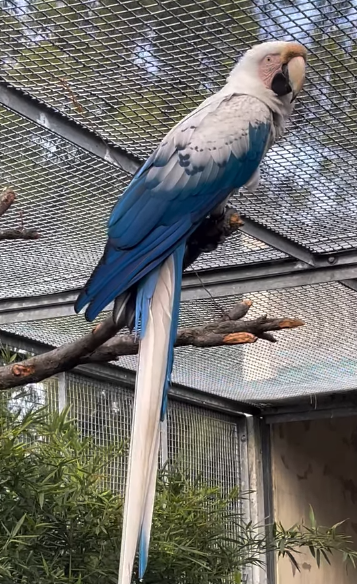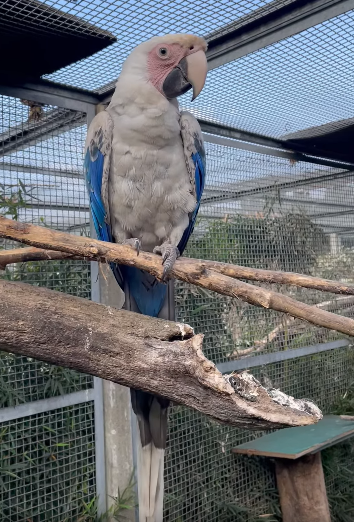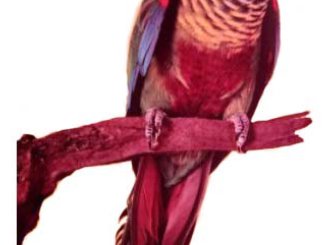Scarlet Macaw: Breeding, Feeding, Nest box, Mutations
Scarlet Macaw, Ara macao: Scarlet Macaws have been long prized in aviculture for their size and beauty. Not only are they among the largest parrots in the world, but they also have amazing personalities.

Scarlet Macaw Description:
The Scarlet Macaws have especially long tails, which are often as long as their bodies. Scarlet Macaws are a brilliant red with yellow coverts on the wings and dark blue flight feathers. They are distinguished from the similar Greenwing Macaw by size (the Greenwing is larger) and by the colour of the wing coverts, and by the lack of facial feathers. Their naked facial skin is white with no feather lines. The tail is long and tapered. The under-tail coverts and rump patch are blue.
Scarlet Macaws can reach an impressive length 80 – 97cm and weigh in at around 900-1200 grams. They can live as long as 50 years and mature at around 3 to 6 years. Immature birds have dark eyes that change over time from black to grey to white to yellow.
This progression can be used to estimate the age of a macaw. Macaws are not as long-lived as cockatoos. The breeding age is up to approximately 30-35 years. A 40-year-old macaw shows definite signs of aging. A 50-year-old macaw is very old.
Distribution:
Scarlet Macaws have a wide range, from Mexico southwards through Central America and into the Magdalena Valley of Columbia. East of the Andes it is found in Guianas, south to Eastern Peru, Bolivia, and the northern Mato Grosso area of Brazil.
It is native to humid evergreen forests. In its natural habitat, the Scarlet Macaw is usually seen in pairs or in small family groups of 3 to 4 individuals, which may join together in flocks of up to 30 birds. Groups of up to 50 Scarlet Macaws may roost communally in tall trees, or sometimes in mangroves, and the species can often be seen with other large macaws.
Most feeding takes place in the canopy, the diet consisting of a range of fruits, seeds, nuts, flowers, nectar, bark, and leaves. The Scarlet Macaw, like many other parrots and macaws in its range, also visits exposed river banks, or ‘clay licks’, to ingest soil, a behaviour known as geophagy. The soil may protect the macaw against toxic compounds present in the diet, or it may be taken as a sodium supplement.
Housing:
Due to their large size and powerful mandibles, macaws require special housing. The larger the aviary the better. The benefits of these large aviaries include increased fitness and, equally important, the opportunity for macaws to choose their own partners where several birds of the same species are flown together. The power of their mandibles can and has resulted in deaths.
For breeding purposes, pairs can be housed in an outdoor aviary 2.5m wide X 3.5m long X 2.5m high. This allows them room to fly and play. A shelter area 1.2m wide X 2.5m high X 1.2m deep provides shelter from the heat or cold. The nest box and their feed bowls are inside this shelter. Larger flights of 6m and more have been used successfully by some breeders.
Larger housing also minimizes their interest in destroying their aviary. Small cages where they are bored can lead to them destroying the wire and their possible escape. The concept that if too much space is provided the birds will not breed is false. More room encourages a healthy, well-exercised pair and long-term breeding success.
It should be an area where one of the most vital requirements of captive macaws, the opportunity to gnaw, can be met. This means providing fresh-cut branches on a weekly basis. The aviary framework is best made of metal pipe for breeding pairs. In very large aviaries used to house young birds or pairs out of the breeding season, a wooden framework can be used.
Foraging:
In a large area macaws are less destructive, provided that they have a regular supply of branches to gnaw at. This is very important for all macaws because they need to be kept occupied. There is no better way than destroying branches. They derive great enjoyment and the small pieces of bark, which are often swallowed, are almost certainly beneficial. Hardwood and/or large ropes must be used for perching. Ropes hung vertically will also provide a lot of amusement.
In addition to commercially available housing, some owners have built beautiful environments for their macaws. They may incorporate enclosing a porch, building a backyard aviary, or re-modelling a room in their home to properly house the bird. Some have even incorporated waterfalls, rope swings, and wooden jungle gyms as play items. This type of environment is not only more stimulating and healthier for the bird, but more enjoyable for their owners. Watching them swinging from a cotton rope, bathing in a small pool under a waterfall, or climbing all over a wooden structure is much more enjoyable than seeing them in a small cage.
Scarlet Macaw Diet:
Throughout the birds’ growing process and prior to breeding, the bird should have a well-balanced diet. An ideal diet would include seeds, nuts, fruits, vegetables, and possibly some form of pellet diet as a supplement. They must be on a good diet long before you see the first egg to ensure optimal fertility. Extra calcium is often needed in the hen’s diet and a good natural source for calcium is almonds. Nuts are readily eaten by macaws.
Food can play an important part in relieving boredom. I believe that large parrots should be fed twice a day – and three times when there are young in the nest. Large macaws care in the breeding centre at Palmitos Park always had nuts twice a day – until the supervisor was admonished for spending too much money on nuts.
It is a fact, however, that the Hyacinths have not bred since the diet was changed. High-fat foods are essential if the large macaws are to breed. The most successful collections are those that feed nuts in good quantities. In one, the curator related that Hyacinths were not bred until macadamia nuts were provided. Macadamia nuts are not essential, but a diet that approximates the high-fat content of the palm nuts on which most macaws feed is essential.
Breeding:
Breeding Macaws, like most large parrots, takes time and patience and once you have established a young bonded pair of Macaws they will provide you with many years of breeding. For newcomers who may not be familiar with all the terms of different pairs you can come across in the various classifieds here are some you might encounter. “Proven Pair” means that the pair of birds has produced eggs or young at some time in their life.
“Producing pair” implies that the birds have recently produced either eggs or young. “Bonded pair” just means that the birds appear to be compatible with each other (this does not assure that they will necessarily breed or are of the opposite sex). Proven or producing pairs normally cost far more than two separate birds of opposite sexes as it is assumed that these birds will breed faster than, let’s say, a bonded pair.
It has been said that the best success with macaws has come from captive bred stock. These successes have come from birds that have been hand-reared and parent-reared by aviculturists. In the past, many of the pairs Scarlet Macaws found in aviculture were from wild caught stock and many of the older wild-caught pairs took far longer (as much as four years longer) to breed than captive-bred birds.
Captive-bred birds were also much calmer and more adaptable to new situations. In the long run, it may be better for aviculturists to acquire young captive-bred macaws and wait the three to four years necessary for them to breed. The initial cost is less, and long-term breeding may be more advantageous.
Nest boxes:
Large horizontal wooden boxes (approx. 60cm x 60cm x 90cm or 120cm) are well accepted by large macaws while some will breed well in a vertical wooden box (approx. 30cm x 30cm x 90cm). Macaws should be provided with plentiful chewing material. Pine shavings make excellent nest box bedding.
A breeding pair of Scarlet Macaws can become quite aggressive and nervous during breeding time, more so than the Blue and Gold Macaws. This makes it difficult to check the nest for eggs and chicks. Clutch size is around two to four eggs with 25 – 26 days being around the normal incubation period.
When eggs are removed for artificial incubation it can trigger the hen to lay eggs in a ‘string’ rather than in a typical clutch fashion. A hen that is in prime breeding condition and age will produce these strings of eggs without any ill effects on her health, and she will naturally stop laying after she has laid the number of eggs that would typically be produced in three clutches. Some people may frown on this but in reality, macaws naturally replace eggs that are lost, even in the wild.
This ability to continue ovulation is part of their natural breeding behaviour and has little or no effect on healthy breeding stock. Hand-reared young can become independent at around 15 – 17 weeks and start to fly at around 14 weeks. Parent-reared young will spend about 14 weeks in the nest.
You may also choose to allow your macaws to hatch and rear their young, which can be a convenient option and a rewarding experience. Having them break the eggs or kill the chicks can also be rather depressing if it happens. Both scenarios are possible with individual breeding pairs.
Hand rearing:
Hand rearing of captive born parrots has become a method of choice for most aviculturists nowadays, most likely due to an increased production and survival rate. Macaw chicks are easy to hand feed. Commercial hand-rearing formulas are appropriate for most species of macaws.
Here are a few guidelines:
• On days 1-4 feed formulas should be very thin to promote proper hydration
• Keep chicks under one week of age at near-hatch temperatures
• Slowly reduce brood temperatures by a degree every few days
• At 4 or 5 weeks of age chicks can be maintained at room temperatures if protected from draughts.
• Offer fresh foods, pelleted diets, seed, and shelled nuts at about 8 – 12 weeks of age
• Monitor weight during weaning and do not allow a loss of more than 18% of total body weight.
From the time the chick hatches it is important that they are not fed too soon as this can kill the chick. A newly hatched chick should be allowed to dry, gain enough strength to stand up, defecate several times and to beg for food when it feels your presence. This period can vary but is generally within 12 – 24 hours of hatching.
Scarlet Macaw Status:
Although the Scarlet Macaw still has a large range and is locally common, there is evidence that the species is declining throughout its range as a result of habitat loss, hunting for food and feathers, and capture for the pet trade. The Scarlet Macaw is widespread in captivity and common in aviculture around the world, but although international trade is banned under its listing on Appendix I of the Convention on International Trade in Endangered Species (CITES), illegal trade persists.
Illegal poaching of nests is often a major problem, and legislation is not always enforced. In addition, the methods used to collect nestlings are not sustainable, as nesting trees are cut down or nest cavities opened, destroying already limited nesting sites.
Conclusion:
Overall, the Scarlet Macaw, Ara macao, is a beautiful species to work with. One must understand the requirements these large parrots need before considering acquiring them and it is always best to try and get a pair of captive-bred unrelated birds. Allowing these birds to bond with each other and breed and rear their young really gives them a stimulating and fulfilled life in captivity. Just one nest, or even allowing them to rear just one chick, will occupy them for at least seven months of the year.
Watching a large macaw like the Scarlet Macaw rear its young to independence can be a rewarding experience for any aviculturist!
Scarlet macaw mediation the most Awesome Beautiful Birds.
Scarlet Macaw mutations (Tony Silva):
The silver Scarlet Macaw. These were bred at Temaiken in Argentina from Ara macao macao parents.


All photos: Courtesy Tony Silva
Further research about other Macaw species:


